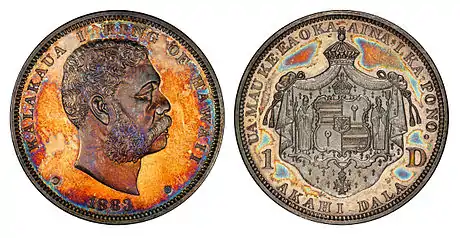| Dala (Hawaiian) | |
|---|---|
Kingdom of Hawaii 1883 dollar | |
| Unit | |
| Plural | dollars (dalas) |
| Symbol | $ |
| Denominations | |
| Subunit | |
| 1⁄100 | cent (keneta) |
| Plural | |
| cent (keneta) | cents (keneta) |
| Banknotes | $10, $20, $50 and $100 (silver coin deposit certificates) |
| Coins | one dime (umi keneta), quarter dollar (hapaha), half dollar (hapalua) and one dollar (akahi dala) |
| Demographics | |
| User(s) | |
| Issuance | |
| Monetary authority | Department of Finance |
| Mint | San Francisco Mint (struck coins for circulation) and Philadelphia Mint (struck presentation proofs) |
| Valuation | |
| Pegged with | United States dollar at par |
| This infobox shows the latest status before this currency was rendered obsolete. | |

The dollar or dala[1] was the currency of Hawaii between 1847 and 1898. It was equal to the United States dollar and was divided into 100 cents or keneta. Only sporadic issues were made, which circulated alongside United States currency.
Coins
The first official coinage issued by the Kingdom of Hawai'i was in 1847. This coin was a copper cent bearing the portrait of King Kamehameha III on its obverse. The King Kamehameha III copper cent proved to be unpopular due to the King's portrait being of poor quality. Although it is claimed the denomination was misspelled (hapa haneri instead of hapa haneli),[2] the spelling "Hapa Haneri" was correct until the end the 19th century. The spelling "Haneri" (Hawaiian for "Hundred") appears on all $100 and $500 Hawaiian bank notes in circulation between 1879 and 1900.[3][4][5]
In 1883, Kingdom of Hawai'i official silver coinage were issued in the denominations of one dime (umi keneta in Hawaiian), quarter dollar (hapaha), half dollar (hapalua) and one dollar (akahi dala). 26 proof sets were struck by the Philadelphia Mint and contained the umi keneta, hapaha, hapalua, and akahi dala. 20 proof specimens in the denomination of an eighth dollar (hapawalu) were also struck. The Kingdom of Hawai'i desired to conform to the United States silver coinage denominations and selected the umi keneta over the hapawalu. The silver coins issued for circulation in the Kingdom was struck by the San Francisco Mint.
Hawaiian coins continued to circulate for several years after the 1898 annexation to the United States. In 1903, an act of Congress demonetized Hawaiian coins effective January 1st, 1904,[6] and most were withdrawn and melted, with a sizable percentage of surviving examples made into jewelry. Following melting, the maximum number of each circulating coin that could possibly exist is as follows:
- Umi Keneta - 1 Dime: 249,921
- Hapaha - 1/4 Dollar: 242,600
- Hapalua - 1/2 Dollar: 87,700
- Akahi Dala - 1 Dollar: 46,300
Banknotes
In 1879, the Department of Finance issued Hawaiʻi's first paper money, silver coin deposit certificates for $10, $20, $50 and $100. However, these notes were issued only in small numbers and US notes made up the bulk of circulating paper money.[7] From 1884, only US gold coins were legal tender for amounts over $10.[8]
In 1897, the Republic of Hawaii issued silver coin deposit certificates for $5, $10, $20, $50 and $100. In 1899, banknotes backed by gold deposits were issued in the same denominations. All Hawaiian notes, especially the gold certificates, are extremely rare today.
See also
References
- ↑ Dala was the spelling used at the time, though during the preparations for minting Edward Preston asked Claus Spreckels whether to spell it dala or kala. Adler, Jacob (April 1966). "Correspondence on the Kalakaua Coinage" (PDF). Hawaiian Historical Review. II (3): 297–300. Retrieved 2018-12-09 – via University of Hawaii at Manoa Library. The spelling in the modern Hawaiian alphabet would be kālā. See Elbert, Samuel H.; Pukui, Mary Kawena (2001). Hawaiian Grammar. University of Hawaii Press. ISBN 9780824824891.
- ↑ "Hawaii's Coinage 1847-1883 - CoinSite". coinsite.com. Archived from the original on 2013-08-06. Retrieved 2015-09-05.
- ↑ "Image: HwiP.4p100DollarsND1879.jpg". numismondo.com. Archived from the original on 2011-09-26. Retrieved 2015-09-05.
- ↑ "Image: HwiP.5p500DollarsND1879.jpg". numismondo.com. Archived from the original on 2012-03-14. Retrieved 2015-09-05.
- ↑ "Image: HwiP.UNL15100Dollars1895SerC.jpg". numismondo.com. Archived from the original on 2012-03-14. Retrieved 2015-09-05.
- ↑ United States, Congress. Public Law 57-25-2. An Act Relating to Hawaiian silver coinage and silver certificates. 14 Jan. 1903. 32 Stat. 770, Chap 186.
- ↑ "The Morgan Report, p. 758". morganreport.org. Retrieved 2015-09-05.
- ↑ "The Morgan Report, p. 416". morganreport.org. Retrieved 2015-09-05.
- Krause, Chester L.; Clifford Mishler (1991). Standard Catalog of World Coins: 1801–1991 (18th ed.). Krause Publications. ISBN 0873411501.
- Medcalf, Donald & Ronald Russell (1991). Hawaiian Money: Standard Catalog: Second Edition. Honolulu: Nani Stamp & Coin LTD. ISBN 0-9623263-0-5.
- Pick, Albert (1994). Standard Catalog of World Paper Money: General Issues. Colin R. Bruce II and Neil Shafer (editors) (7th ed.). Krause Publications. ISBN 0-87341-207-9.
